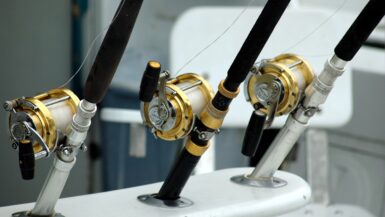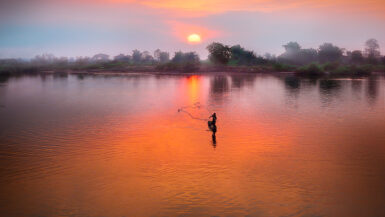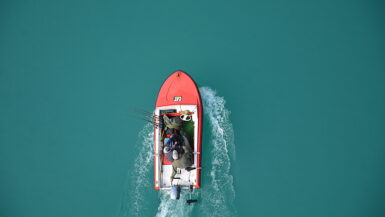The practice of catch and release is an integral part of responsible fishing. It helps to ensure that freshwater fish populations are managed carefully and sustainably for future generations of anglers to enjoy. This article will discuss the importance of catch and release and the steps involved in practicing responsible fishing in freshwater. It will explain why it is important to practise catch and release and to use proper handling and safety equipment when fishing in freshwater. Furthermore, it will provide information on how to release a fish properly and the different legal regulations in place to protect fish populations.
What is Catch and Release Fishing?
Catch and release fishing has been practiced for centuries, but it wasn’t until the 20th century that it became widely adopted in freshwater gamefishing. It was first popularized in the U.S. by conservationists and anglers in the 1960s and 1970s as a way to improve fisheries management and limit the impact of fishing on the fish population.
Benefits of Catch and Release Fishing
The practice of catch and release fishing has many benefits for the environment and the fish population. It helps fish to survive after being caught and allows them to be caught again in the future, which encourages anglers to practice responsible fishing. It also helps to maintain ecological balance and fish populations, as well as conserve resources. Additionally, it can reduce the pressure on areas with high fishing pressure.
How to Practice Catch and Release Fishing
Catch and release fishing can be practiced in a variety of ways. First, use barbless hooks to make it easier to release the fish. Secondly, use the right tackle for the species you are targeting and make sure to use the lightest possible line for the size of the fish. Thirdly, always handle the fish with wet hands or a fish gripper and avoid touching or squeezing the fish’s body or fins. Finally, if the fish is in distress, move it to deeper water and revive it before releasing it back into the water.
Importance of Catch and Release Fishing
Catch and release fishing is an important practice for responsible anglers. It helps to ensure that fish populations remain healthy and helps to conserve resources. It is also important to practice catch and release responsibly to avoid causing any unnecessary harm to the fish. With this in mind, anglers should always practice proper fish handling techniques to ensure that the fish is safely released back into the water.
Benefits of Catch and Release Fishing
Catch and release fishing is an important practice for preserving freshwater fish populations. By practising catch and release, anglers can help reduce overfishing and maintain the balance of a healthy aquatic ecosystem. There are many environmental benefits to catch and release fishing, including:
- Conserving fish populations: Catch and release fishing reduces the number of fish caught, allowing the fish to live longer and spawn multiple times, maintaining healthy fish populations.
- Maintaining a proper food chain: By allowing fish to live longer, catch and release fishing ensures that there are enough prey species such as insects and baitfish to support healthy predator species, helping maintain a proper food chain.
- Protecting delicate ecosystems: By catching and releasing fish, anglers can protect delicate aquatic ecosystems, ensuring they last for generations to come.
- Improving water quality: Fish help keep the waters clean by eating decaying matter and removing algae and other organisms from the water. By releasing the fish, the natural balance of the water is maintained and pollutants are kept to a minimum.
Techniques for Successful Catch and Release Fishing
For catch and release fishing to be successful, anglers must use the proper techniques. To maximize the probability of survival, the following steps should be taken:
- Use barbless hooks. Barbs make it difficult to remove hooks, which can cause injury to the fish.
- Handle the fish with care. To minimize stress, keep the fish in the water as much as possible and avoid touching the gills and eyes.
- Use a net with a soft mesh. This helps reduce stress and the chances of the fish being injured.
- Keep the fish in the water while unhooking. If you must take the fish out of the water, do it quickly and gently.
- Release the fish carefully. When releasing the fish, make sure it is healthy and strong before letting it go.
Motivation for Practicing Catch and Release Fishing
Catch and release fishing has become a popular practice, not just for the environmental benefits but also for the recreational aspect. Many anglers enjoy the thrill of catching and releasing the fish. By practising catch and release, anglers not only protect the environment and help maintain the balance of the aquatic ecosystem, but also get to experience the thrill of a bite and the satisfaction of letting the fish go unharmed.
How to Practice Responsible Catch and Release Fishing
Catch and release fishing is an increasingly popular practice among freshwater fishermen, providing a number of benefits to both fish populations and recreational anglers. This method of fishing helps to conserve fish populations by allowing fish to maintain their genetic diversity and remain available for future anglers to catch. In addition, catch and release fishing can help to protect fisheries from overfishing and provide a sustainable form of sport fishing.
Responsible Practices for Catch and Release Fishing
In order to practice responsible catch and release fishing, anglers should take a few simple steps to ensure the health and well-being of the fish they release. The most important step is to handle the fish with care and avoid causing unnecessary stress or harm. This means avoiding touching the gills, handling the fish with dry hands, and using wet towels or gloves to hold fish. It is also important to wet the line before releasing the fish and making sure that it is not tangled or tangled in its mouth.
Minimize Stress When Releasing Fish
Once the fish is caught, it is important to minimize the amount of time it spends out of the water. Anglers should make sure that the fish is ready for release before taking it out of the water, as this will prevent excessive handling and reduce the risk of causing harm. Additionally, it is important to use the appropriate tackle for the type of fish being caught, as using heavy tackle can cause serious harm to smaller fish. Some anglers also opt to use barbless hooks, which make releasing a fish easier and less stressful.
Use Appropriate Releasing Techniques
When releasing a fish, it is important to use the appropriate technique in order to ensure that the fish has the highest chance of survival. This means gently placing the fish into the water, rather than throwing it, and releasing it slowly and carefully. Additionally, some anglers opt to use a tool such as a de-hooker or landing net to release the fish. Doing so allows them to avoid touching the fish, which can cause unnecessary stress.
Consider Regulations and Restrictions
In addition to practicing responsible catch and release fishing techniques, anglers should also be aware of local regulations and restrictions regarding catch and release fishing. These regulations can vary from state to state, so it is important to familiarize yourself with the regulations for the area you are fishing in before you begin fishing. Additionally, some areas may have restrictions on the type of tackle or bait that can be used for catch and release fishing, so it is important to be familiar with these restrictions as well.
Tips for Selecting the Right Tackle for Catch and Release Fishing
Catch and release fishing is a popular and responsible way to enjoy freshwater angling, but it’s important to use the right tackle to ensure a successful outcome. For starters, you’ll want to make sure you select the right fishing rod and reel for the fish you’re targeting. A lightweight rod is best for panfish, while a medium-heavy or heavy-action rod is ideal for larger species like bass or walleye. When selecting a reel, look for one with a good drag system to help you land your catch quickly and safely.
Choose Hooks That Easily Detach from Fish
The type of hook you use is important for catch and release fishing. You’ll want to opt for a hook that is either barbless or has an offset design, which makes it easier to remove from the fish’s mouth. These types of hooks also cause less stress and damage to the fish, so it can be safely released back into the water.
Consider the Fish Species You are Targeting
Different fish species have different tackle requirements. For example, carp typically require heavier line and bigger hooks. If you’re targeting trout, look for a light line and a small hook. When fishing for catfish, you’ll want to make sure the hook is weighted to keep it on the bottom of the river or lake.
Use Terminal Tackle That Will Not Harm the Fish
Terminal tackle like sinkers and bobbers should also be selected with catch and release fishing in mind. Choose sinkers that are lightweight and shaped like smooth cylinders, as these will cause less damage to the fish if it swallows the hook. And if you’re using a float, look for one that is biodegradable or made from a material that is quickly broken down by water.
Opt for Lures and Baits That are Easily Removed
Lures and baits can also play an important role when it comes to catch and release fishing. Look for lures and baits that are easily removable from the fish’s mouth. Artificial lures, in particular, are ideal for catch and release fishing, as they can be quickly taken off the fish with minimal effort.
Know the Regulations for Catch and Release Fishing in Your Area
Finally, it’s important to be aware of the local regulations for catch and release fishing in your area. Before you head out fishing, be sure to check the local regulations to make sure you’re abiding by the rules. Most states and provinces have regulations in place to help ensure the safety and health of fish populations.
Preparing the Fish for Release
Catch and release can be a wonderful way to enjoy the sport of freshwater fishing without harming the environment or depleting fish stocks. As part of the practice, however, anglers must take the time to properly restore the fish before releasing it back into the water. Improper release techniques can have serious long-term consequences on fish populations and the overall fishing experience.
Reducing Stress on the Fish
The most important way to ensure a successful catch and release is to minimize the stress on the fish. Stress can cause lasting damage to fish and adversely affect their chances of survival upon release. To reduce stress during the catch and release process, anglers should handle the fish as infrequently and as gently as possible.
Using Wet Hands
It is also important to use wet hands when handling the fish. This will help reduce the amount of slime that is removed from the fish’s body, which can increase its vulnerability to disease and parasites. In addition, removing the hook should be done carefully and quickly to reduce the amount of time that the fish is out of the water and exposed to air.
Gently Releasing the Fish
Once the fish has been successfully released, it is important to ensure that it is gently returned to the water. If the fish has been out of the water for some time, it may need to be held in the water until it revives and can swim away on its own. Additionally, anglers should be careful not to throw the fish when releasing it, as this can cause injury and further stress.
Practicing Responsible Catch and Release
By taking the time to properly restore the fish before release, anglers can help ensure that their fishing activities are more sustainable and beneficial for fish populations. When done correctly, catch and release can be an enjoyable and rewarding way to responsibly enjoy the sport of freshwater fishing.
Tips for Properly Handling the Fish During and After Release
When it comes to catch and release fishing, understanding the stress levels of the fish is key. Fish can be easily stressed, so during and after they’re caught, it’s important to handle them gently and properly. When fishing with a net, be sure to minimize the time it spends in the water, as too much time can cause the fish to stress out. After the fish is out of the water, support its body and handle it with wet hands. Holding the fish at the bottom of its body can help maneuver it without causing harm.
Keep the Fish Wet During Transport
If you need to transport the fish, be sure to keep it wet. If possible, keep the fish in the water while transporting them to the new body of water. If this isn’t possible, keep the fish in a wet container and be sure to keep it out of direct sunlight and in the shade. Fill the container with oxygenated water and make sure the water temperature is close to the temperature of the fish’s original water body.
Timely Release of Fish Into New Water Source
When releasing the fish into a new water source, the timing is of the essence. Be sure to get the fish back into the water in a timely manner and not wait too long. This is because a fish can suffer from oxygen deprivation when out of the water for too long. Releasing the fish gently into the water is also important.
Be Mindful of the Fish’s Environment During Release
After release, the fish will need time to adjust. Be sure to let the fish rest in a shallow part of the water body before moving on. If you’re fishing in a deeper part of the water, be sure to let the fish rest for a few minutes in the shallow part before it goes back to the depths. Also, be mindful of the environment you’re releasing the fish into. Make sure the environment isn’t too crowded with predators and that there’s plenty of food and oxygen available.
Properly Clean and Disinfect Fishing Gear
Finally, be sure to properly clean fishing gear and equipment and disinfect it before releasing the fish. This will help prevent the spread of disease and preserve the health of the fish in the waterbody. Make sure to clean and sanitize hooks, nets, and any other equipment used to catch the fish. This will help prevent overcrowding in the waterbody and preserve the health of the population.
The Benefits of Catch and Release Fishing
Catch and release fishing is a great way for anglers to enjoy the sport of fishing without hurting the fish population. By understanding the reasons and the techniques behind catch and release fishing, anglers are able to ensure that the fish are released back into the water unharmed and ready to reproduce. Not only does using this method benefit the fish population, it also allows anglers to enjoy more fishing experiences with more fish sightings year after year. With these advantages, catch and release fishing is a great way to practice responsible fishing in freshwater and keep the environment healthy.





Leave a reply